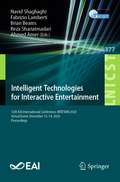 Intelligent Technologies for Interactive Entertainment: 12th EAI International Conference, INTETAIN 2020, Virtual Event, December 12-14, 2020, Proceedings (Lecture Notes of the Institute for Computer Sciences, Social Informatics and Telecommunications Engineering #377)
4015198
Intelligent Technologies for Interactive Entertainment: 12th EAI International Conference, INTETAIN 2020, Virtual Event, December 12-14, 2020, Proceedings (Lecture Notes of the Institute for Computer Sciences, Social Informatics and Telecommunications Engineering #377)
4015198
|
Navid Shaghaghi
Fabrizio Lamberti
Brian Beams
Reza Shariatmadari
Ahmed Amer
|
9783030764265 |
2021 |
Contains images
|
|
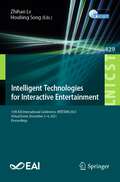 Intelligent Technologies for Interactive Entertainment: 13th EAI International Conference, INTETAIN 2021, Virtual Event, December 3-4, 2021, Proceedings (Lecture Notes of the Institute for Computer Sciences, Social Informatics and Telecommunications Engineering #429)
4484066
Intelligent Technologies for Interactive Entertainment: 13th EAI International Conference, INTETAIN 2021, Virtual Event, December 3-4, 2021, Proceedings (Lecture Notes of the Institute for Computer Sciences, Social Informatics and Telecommunications Engineering #429)
4484066
|
Houbing Song
Zhihan Lv
|
9783030991883 |
2022 |
Contains images
|
|
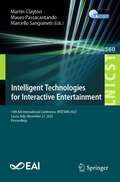 Intelligent Technologies for Interactive Entertainment: 14th EAI International Conference, INTETAIN 2023, Lucca, Italy, November 27, 2023, Proceedings (Lecture Notes of the Institute for Computer Sciences, Social Informatics and Telecommunications Engineering #560)
5940225
Intelligent Technologies for Interactive Entertainment: 14th EAI International Conference, INTETAIN 2023, Lucca, Italy, November 27, 2023, Proceedings (Lecture Notes of the Institute for Computer Sciences, Social Informatics and Telecommunications Engineering #560)
5940225
|
Martin Clayton
Mauro Passacantando
Marcello Sanguineti
|
9783031557224 |
2024 |
Contains images
|
|
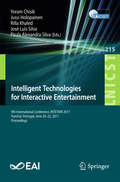 Intelligent Technologies for Interactive Entertainment: 9th International Conference, INTETAIN 2017, Funchal, Portugal, June 20-22, 2017, Proceedings (Lecture Notes of the Institute for Computer Sciences, Social Informatics and Telecommunications Engineering #215)
2272942
Intelligent Technologies for Interactive Entertainment: 9th International Conference, INTETAIN 2017, Funchal, Portugal, June 20-22, 2017, Proceedings (Lecture Notes of the Institute for Computer Sciences, Social Informatics and Telecommunications Engineering #215)
2272942
|
Yoram Chisik
Jussi Holopainen
Rilla Khaled
José Luis Silva
Paula Alexandra Silva
|
9783319730622 |
2018 |
Contains images
|
|
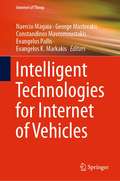 Intelligent Technologies for Internet of Vehicles (Internet of Things)
4053278
Intelligent Technologies for Internet of Vehicles (Internet of Things)
4053278
|
George Mastorakis
Evangelos Pallis
Naercio Magaia
Constandinos Mavromoustakis
Evangelos K. Markakis
|
9783030764937 |
2021 |
Contains images
|
|
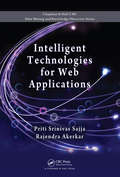 Intelligent Technologies for Web Applications
6077530
Intelligent Technologies for Web Applications
6077530
|
Rajendra Akerkar
Priti Srinivas Sajja
|
9781040053157 |
2012 |
Contains images
|
|
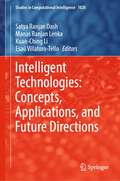 Intelligent Technologies: Concepts, Applications, and Future Directions (Studies in Computational Intelligence #1028)
4557432
Intelligent Technologies: Concepts, Applications, and Future Directions (Studies in Computational Intelligence #1028)
4557432
|
Kuan-Ching Li
Satya Ranjan Dash
Manas Ranjan Lenka
Esaú Villatoro-Tello
|
9789811910210 |
2022 |
Contains images
|
|
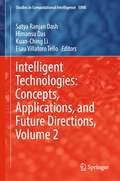 Intelligent Technologies: Concepts, Applications, and Future Directions, Volume 2 (Studies in Computational Intelligence #1098)
5373028
Intelligent Technologies: Concepts, Applications, and Future Directions, Volume 2 (Studies in Computational Intelligence #1098)
5373028
|
Kuan-Ching Li
Himansu Das
Satya Ranjan Dash
Esau Villatoro Tello
|
9789819914821 |
2023 |
Contains images
|
|
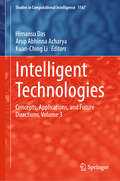 Intelligent Technologies: Concepts, Applications, and Future Directions, Volume 3 (Studies in Computational Intelligence #1167)
6201722
Intelligent Technologies: Concepts, Applications, and Future Directions, Volume 3 (Studies in Computational Intelligence #1167)
6201722
|
Kuan-Ching Li
Himansu Das
Arup Abhinna Acharya
|
9789819752041 |
2024 |
Contains images
|
|
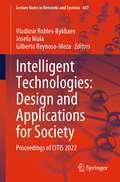 Intelligent Technologies: Proceedings of CITIS 2022 (Lecture Notes in Networks and Systems #607)
5263236
Intelligent Technologies: Proceedings of CITIS 2022 (Lecture Notes in Networks and Systems #607)
5263236
|
Josefa Mula
Vladimir Robles-Bykbaev
Gilberto Reynoso-Meza
|
9783031243271 |
2023 |
Contains images
|
|
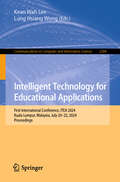 Intelligent Technology for Educational Applications: First International Conference, ITEA 2024, Kuala Lumpur, Malaysia, July 20–22, 2024, Proceedings (Communications in Computer and Information Science #2384)
6523182
Intelligent Technology for Educational Applications: First International Conference, ITEA 2024, Kuala Lumpur, Malaysia, July 20–22, 2024, Proceedings (Communications in Computer and Information Science #2384)
6523182
|
Lung Hsiang Wong
Kean Wah Lee
|
9789819640904 |
2025 |
Contains images
|
|
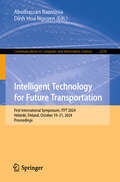 Intelligent Technology for Future Transportation: First International Symposium, ITFT 2024, Helsinki, Finland, October 19–21, 2024, Proceedings (Communications in Computer and Information Science #2378)
6516317
Intelligent Technology for Future Transportation: First International Symposium, ITFT 2024, Helsinki, Finland, October 19–21, 2024, Proceedings (Communications in Computer and Information Science #2378)
6516317
|
Abolhassan Razminia
Dinh Hoa Nguyen
|
9783031841484 |
2025 |
Contains images
|
|
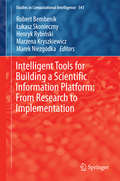 Intelligent Tools for Building a Scientific Information Platform: From Research to Implementation
1404199
Intelligent Tools for Building a Scientific Information Platform: From Research to Implementation
1404199
|
Marzena Kryszkiewicz
Henryk Rybiński
Robert Bembenik
Łukasz Skonieczny
Marek Niezgódka
|
9783319047140 |
2014 |
Contains images
|
|
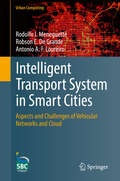 Intelligent Transport System in Smart Cities: Aspects and Challenges of Vehicular Networks and Cloud (Urban Computing)
2277298
Intelligent Transport System in Smart Cities: Aspects and Challenges of Vehicular Networks and Cloud (Urban Computing)
2277298
|
Rodolfo I. Meneguette
Robson E. De Grande
Antonio A. F. Loureiro
|
9783319933320 |
2018 |
Contains images
|
|
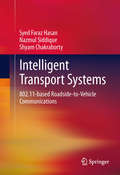 Intelligent Transport Systems
654614
Intelligent Transport Systems
654614
|
Nazmul Siddique
Shyam Chakraborty
Syed Faraz Hasan
|
9781461432722 |
2013 |
Contains images
|
|
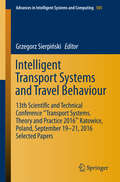 Intelligent Transport Systems and Travel Behaviour
1529698
Intelligent Transport Systems and Travel Behaviour
1529698
|
Grzegorz Sierpiński
|
9783319439914 |
2017 |
Contains images
|
|
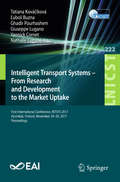 Intelligent Transport Systems – From Research and Development to the Market Uptake: First International Conference, INTSYS 2017, Hyvinkää, Finland, November 29-30, 2017, Proceedings (Lecture Notes of the Institute for Computer Sciences, Social Informatics and Telecommunications Engineering #222)
2118503
Intelligent Transport Systems – From Research and Development to the Market Uptake: First International Conference, INTSYS 2017, Hyvinkää, Finland, November 29-30, 2017, Proceedings (Lecture Notes of the Institute for Computer Sciences, Social Informatics and Telecommunications Engineering #222)
2118503
|
Giuseppe Lugano
Tatiana Kováčiková
Ľuboš Buzna
Ghadir Pourhashem
Yannick Cornet
Nathalie Lugano
|
9783319937106 |
2018 |
Contains images
|
|
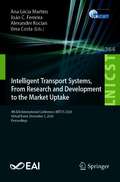 Intelligent Transport Systems, From Research and Development to the Market Uptake: 4th EAI International Conference, INTSYS 2020, Virtual Event, December 3, 2020, Proceedings (Lecture Notes of the Institute for Computer Sciences, Social Informatics and Telecommunications Engineering #364)
3894120
Intelligent Transport Systems, From Research and Development to the Market Uptake: 4th EAI International Conference, INTSYS 2020, Virtual Event, December 3, 2020, Proceedings (Lecture Notes of the Institute for Computer Sciences, Social Informatics and Telecommunications Engineering #364)
3894120
|
Ana Lúcia Martins
Alexander Kocian
João C. Ferreira
Vera Costa
|
9783030714543 |
2021 |
Contains images
|
|
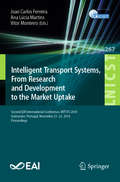 Intelligent Transport Systems, From Research and Development to the Market Uptake: Second EAI International Conference, INTSYS 2018, Guimarães, Portugal, November 21–23, 2018, Proceedings (Lecture Notes of the Institute for Computer Sciences, Social Informatics and Telecommunications Engineering #267)
2447745
Intelligent Transport Systems, From Research and Development to the Market Uptake: Second EAI International Conference, INTSYS 2018, Guimarães, Portugal, November 21–23, 2018, Proceedings (Lecture Notes of the Institute for Computer Sciences, Social Informatics and Telecommunications Engineering #267)
2447745
|
Joao Carlos Ferreira
Ana Lúcia Martins
Vitor Monteiro
|
9783030147570 |
2019 |
Contains images
|
|
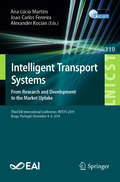 Intelligent Transport Systems. From Research and Development to the Market Uptake: Third EAI International Conference, INTSYS 2019, Braga, Portugal, December 4–6, 2019 (Lecture Notes of the Institute for Computer Sciences, Social Informatics and Telecommunications Engineering #310)
3409138
Intelligent Transport Systems. From Research and Development to the Market Uptake: Third EAI International Conference, INTSYS 2019, Braga, Portugal, December 4–6, 2019 (Lecture Notes of the Institute for Computer Sciences, Social Informatics and Telecommunications Engineering #310)
3409138
|
Joao Carlos Ferreira
Ana Lúcia Martins
Alexander Kocian
|
9783030388225 |
2020 |
Contains images
|
|
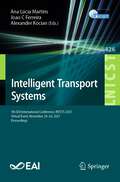 Intelligent Transport Systems: 5th EAI International Conference, INTSYS 2021, Virtual Event, November 24-26, 2021, Proceedings (Lecture Notes of the Institute for Computer Sciences, Social Informatics and Telecommunications Engineering #426)
4508584
Intelligent Transport Systems: 5th EAI International Conference, INTSYS 2021, Virtual Event, November 24-26, 2021, Proceedings (Lecture Notes of the Institute for Computer Sciences, Social Informatics and Telecommunications Engineering #426)
4508584
|
Ana Lúcia Martins
Alexander Kocian
Joao C Ferreira
|
9783030976033 |
2022 |
Contains images
|
|
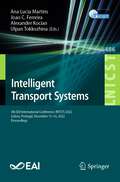 Intelligent Transport Systems: 6th EAI International Conference, INTSYS 2022, Lisbon, Portugal, December 15-16, 2022, Proceedings (Lecture Notes of the Institute for Computer Sciences, Social Informatics and Telecommunications Engineering #486)
5308039
Intelligent Transport Systems: 6th EAI International Conference, INTSYS 2022, Lisbon, Portugal, December 15-16, 2022, Proceedings (Lecture Notes of the Institute for Computer Sciences, Social Informatics and Telecommunications Engineering #486)
5308039
|
Alexander Kocian
Ana Lucia Martins
Joao C. Ferreira
Ulpan Tokkozhina
|
9783031308550 |
2023 |
Contains images
|
|
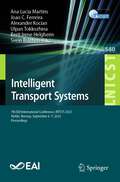 Intelligent Transport Systems: 7th EAI International Conference, INTSYS 2023, Molde, Norway, September 6-7, 2023, Proceedings (Lecture Notes of the Institute for Computer Sciences, Social Informatics and Telecommunications Engineering #540)
5810197
Intelligent Transport Systems: 7th EAI International Conference, INTSYS 2023, Molde, Norway, September 6-7, 2023, Proceedings (Lecture Notes of the Institute for Computer Sciences, Social Informatics and Telecommunications Engineering #540)
5810197
|
Alexander Kocian
Svein Bråthen
Ana Lucia Martins
Joao C. Ferreira
Ulpan Tokkozhina
Berit Irene Helgheim
|
9783031493799 |
2024 |
Contains images
|
|
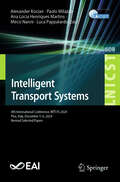 Intelligent Transport Systems: 8th International Conference, INTSYS 2024, Pisa, Italy, December 5–6, 2024, Revised Selected Papers (Lecture Notes of the Institute for Computer Sciences, Social Informatics and Telecommunications Engineering #608)
6503829
Intelligent Transport Systems: 8th International Conference, INTSYS 2024, Pisa, Italy, December 5–6, 2024, Revised Selected Papers (Lecture Notes of the Institute for Computer Sciences, Social Informatics and Telecommunications Engineering #608)
6503829
|
Paolo Milazzo
Alexander Kocian
Mirco Nanni
Ana Lúcia Henriques Martins
Luca Pappalardo
|
9783031863707 |
2025 |
Contains images
|
|
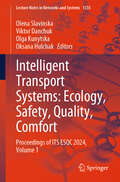 Intelligent Transport Systems: Proceedings of ITS ESQC 2024, Volume 1 (Lecture Notes in Networks and Systems #1335)
6498832
Intelligent Transport Systems: Proceedings of ITS ESQC 2024, Volume 1 (Lecture Notes in Networks and Systems #1335)
6498832
|
Olena Slavinska
Viktor Danchuk
Olga Kunytska
Oksana Hulchak
|
9783031873768 |
2025 |
Contains images
|
|